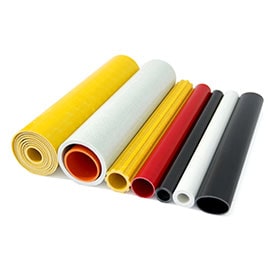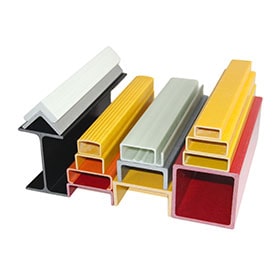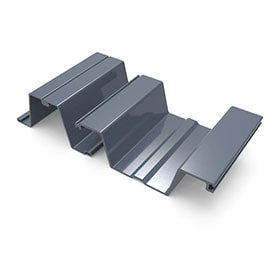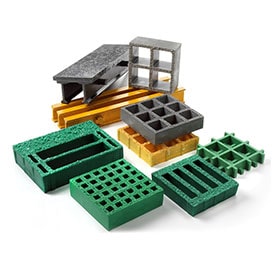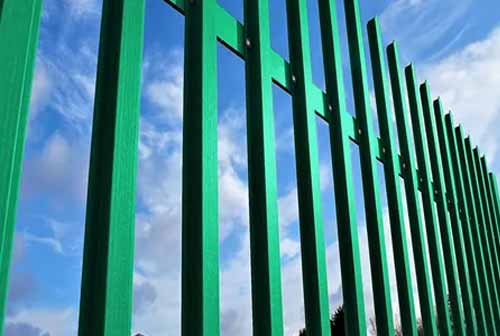
FRP (Fiber Reinforced Polymer) is a composite material that consists of fibers embedded in a polymer matrix. FRP structural profiles are shapes that are formed by pultrusion, a continuous manufacturing process that produces high-strength, lightweight and corrosion-resistant parts. Steel structural profiles are shapes that are formed by rolling, extruding or forging steel, a metal alloy that consists of iron and carbon. Steel structural profiles are widely used in construction, engineering and industrial applications. However, FRP structural profiles have some advantages over steel structural profiles in terms of performance, cost and sustainability. In this article, we will compare FRP and steel structural profiles based on some key criteria.
Performance
One of the main criteria to compare FRP and steel structural profiles is their performance under different conditions and loads. Performance can be measured by various properties, such as strength, stiffness, weight, impact resistance, thermal conductivity and electrical conductivity.
Strength: Strength is the ability of a material to resist deformation or failure under stress. Strength can be expressed by different parameters, such as tensile strength, compressive strength, flexural strength and shear strength. FRP structural profiles have high strength-to-weight ratios, meaning that they can withstand high loads with low weight. For example, glass FRP has a tensile strength of 414 MPa and a weight of 1.8 g/cm3, while A 709 grade 50 steel has a tensile strength of 345 MPa and a weight of 7.8 g/cm3. This means that FRP structural profiles can reduce the dead load and increase the load-bearing capacity of structures.
Stiffness: Stiffness is the ability of a material to resist deformation under stress. Stiffness can be expressed by parameters such as modulus of elasticity or Young’s modulus. FRP structural profiles have lower stiffness-to-weight ratios than steel structural profiles, meaning that they are more flexible and less rigid. For example, glass FRP has a Young’s modulus of 24 GPa and a weight of 1.8 g/cm3, while A 709 grade 50 steel has a Young’s modulus of 200 GPa and a weight of 7.8 g/cm3. This means that FRP structural profiles can accommodate more deflection and vibration without cracking or breaking. However, for stiffness-critical applications, such as airplanes and bicycles, carbon FRP can be used to achieve higher stiffness-to-weight ratios than steel.
Weight: Weight is the mass of a material per unit volume. Weight affects the transportation, installation and maintenance costs of structural profiles. FRP structural profiles have lower weights than steel structural profiles, meaning that they are easier to handle and transport. For example, glass FRP weighs 75 percent less than steel. This means that FRP structural profiles can reduce the fuel consumption and emissions of vehicles and equipment, as well as the labor and equipment costs for installation and maintenance.
Impact resistance: Impact resistance is the ability of a material to absorb energy and resist damage from sudden shocks or collisions.Impact resistance can be measured by parameters such as Charpy impact test or Izod impact test. FRP structural profiles have higher impact resistance than steel structural profiles, meaning that they can withstand more impact without permanent deformation or failure. For example, steel can permanently deform under impact, while the glass mat in pultruded parts distributes impact load to prevent surface damage. This means that FRP structural profiles can provide more durability and safety for structures in harsh environments or under dynamic loads. Thermal conductivity: Thermal conductivity is the ability of a material to transfer heat through its body. Thermal conductivity affects the thermal performance and insulation properties of structures. FRP structural profiles have lower thermal conductivity than steel structural profiles, meaning that they are better insulators and less affected by temperature changes. For example, glass FRP has a thermal conductivity of 0.25 W/mK, while steel has a thermal conductivity of 50 W/mK. This means that FRP structural profiles can reduce heat loss or gain in structures and improve energy efficiency.
Electrical conductivity: Electrical conductivity is the ability of a material to conduct electric current through its body. Electrical conductivity affects the electrical performance and safety of structures. FRP structural profiles have zero electrical conductivity, meaning that they are nonconductive and do not interfere with electromagnetic signals or fields. Steel structural profiles have high electrical conductivity, meaning that they are conductive and can cause electrical hazards or interference. This means that FRP structural profiles can provide more reliability and protection for structures in electrical or magnetic environments.
Cost
Another criterion to compare FRP and steel structural profiles is their cost over their life cycle. Cost can be measured by various factors, such as material cost, fabrication cost, installation cost, maintenance cost and disposal cost.
Material cost: Material cost is the price of raw materials used to produce structural profiles. Material cost depends on the availability, quality and demand of the materials. FRP structural profiles have higher material costs than steel structural profiles, meaning that they are more expensive to purchase. However, material cost is only one component of the total cost and does not reflect the performance and benefits of the materials.
Fabrication cost: Fabrication cost is the cost of processing raw materials into structural profiles. Fabrication cost depends on the complexity, efficiency and quality of the fabrication process. FRP structural profiles have lower fabrication costs than steel structural profiles, meaning that they are cheaper to produce. For example, FRP structural profiles are formed by pultrusion, a simple and continuous process that uses standard tools and does not require welding or cutting. Steel structural profiles are formed by rolling, extruding or forging, which are more complex and intermittent processes that require specialized equipment and skills. Installation cost: Installation cost is the cost of transporting, handling and assembling structural profiles on site.
Installation cost depends on the weight, size and shape of the structural profiles. FRP structural profiles have lower installation costs than steel structural profiles, meaning that they are cheaper to install. For example, FRP structural profiles are lighter and easier to handle and transport than steel structural profiles, which reduces the fuel consumption and emissions of vehicles and equipment, as well as the labor and equipment costs for installation. FRP structural profiles are also easier to assemble and adjust on site than steel structural profiles, which reduces the installation time and errors.
Maintenance cost: Maintenance cost is the cost of repairing, cleaning and protecting structural profiles from deterioration or damage over time. Maintenance cost depends on the durability, corrosion resistance and aesthetic properties of the structural profiles. FRP structural profiles have lower maintenance costs than steel structural profiles, meaning that they are cheaper to maintain. For example, FRP structural profiles are inherently corrosion-resistant, which means that they do not require painting or galvanizing for protection from chemicals, salt or water. Steel structural profiles are subject to oxidation and corrosion, which means that they require periodic painting or galvanizing for protection from chemicals, salt or water. FRP structural profiles also have molded-in color and resin options, which means that they do not fade or peel over time. Steel structural profiles have applied color and coating options, which means that they can fade or peel over time.
Disposal cost: Disposal cost is the cost of removing and disposing of structural profiles at the end of their service life. Disposal cost depends on the environmental impact and recyclability of the structural profiles. FRP structural profiles have higher disposal costs than steel structural profiles, meaning that they are more expensive to dispose of. For example, FRP structural profiles are difficult to recycle due to their composite nature, which means that they have to be landfilled or incinerated. Steel structural profiles are easy to recycle due to their metallic nature, which means that they can be melted and reused. However, disposal cost is only one component of the environmental impact and does not reflect the energy consumption and emissions of the materials.
Sustainability
The final criterion to compare FRP and steel structural profiles is their sustainability over their life cycle. Sustainability can be measured by various indicators, such as energy consumption, greenhouse gas emissions, water consumption, waste generation and resource depletion.
Energy consumption: Energy consumption is the amount of energy used to produce, transport, install, maintain and dispose of structural profiles. Energy consumption affects the environmental impact and economic efficiency of structures. FRP structural profiles have lower energy consumption than steel structural profiles, meaning that they are more energy-efficient and environmentally friendly. For example, FRP structural profiles consume about 20 MJ/kg of energy over their life cycle, while steel structural profiles consume about 200 MJ/kg of energy over their life cycle. This means that FRP structural profiles can reduce the fossil fuel consumption and dependence of structures.
Greenhouse gas emissions: Greenhouse gas emissions are the amount of gases released into the atmosphere that contribute to global warming and climate change. Greenhouse gas emissions affect the environmental impact and social responsibility of structures. FRP structural profiles have lower greenhouse gas emissions than steel structural profiles, meaning that they are more environmentally friendly and socially responsible. For example, FRP structural profiles emit about 1 kg CO2/kg of greenhouse gas over their life cycle, while steel structural profiles emit about 10 kg CO2/kg of greenhouse gas over their life cycle. This means that FRP structural profiles can reduce the carbon footprint and impact of structures.
Water consumption: Water consumption is the amount of water used to produce, transport, install, maintain and dispose of structural profiles. Water consumption affects the environmental impact and water security of structures. FRP structural profiles have lower water consumption than steel structural profiles, meaning that they are more water-efficient and environmentally friendly. For example, FRP structural profiles consume about 0.1 m3/kg of water over their life cycle, while steel structural profiles consume about 1.5 m3/kg of water over their life cycle. This means that FRP structural profiles can reduce the water consumption and impact of structures.
Waste generation: Waste generation is the amount of waste produced by the production, transportation, installation, maintenance and disposal of structural profiles. Waste generation affects the environmental impact and waste management of structures. FRP structural profiles have lower waste generation than steel structural profiles, meaning that they are more waste-efficient and environmentally friendly. For example, FRP structural profiles generate about 0.1 kg/kg of waste over their life cycle, while steel structural profiles generate about 0.5 kg/kg of waste over their life cycle. This means that FRP structural profiles can reduce the waste generation and impact of structures.
Resource depletion: Resource depletion is the amount of natural resources used or consumed by the production, transportation, installation, maintenance and disposal of structural profiles. Resource depletion affects the environmental impact and resource availability of structures. FRP structural profiles have lower resource depletion than steel structural profiles, meaning that they are more resource-efficient and environmentally friendly. For example, FRP structural profiles use about 0.2 kg/kg of non-renewable resources over their life cycle, while steel structural profiles use about 2 kg/kg of non-renewable resources over their life cycle. This means that FRP structural profiles can reduce the resource depletion and impact of structures.
Conclusion
In conclusion, FRP and steel structural profiles have different advantages and disadvantages in terms of performance, cost and sustainability. FRP structural profiles have higher strength-to-weight ratios, lower stiffness-to-weight ratios, lower weight, higher impact resistance, lower thermal conductivity, zero electrical conductivity, lower fabrication costs, lower installation costs, lower maintenance costs, lower energy consumption, lower greenhouse gas emissions, lower water consumption, lower waste generation and lower resource depletion than steel structural profiles. Steel structural profiles have higher stiffness-to-weight ratios, higher thermal conductivity, high electrical conductivity, lower material costs and higher recyclability than FRP structural profiles. Therefore, the choice of structural profile depends on the specific application and design requirements of each project. However, in general, FRP structural profiles offer more benefits than steel structural profiles in terms of performance, cost and sustainability.
 +86 15303735673
+86 15303735673 Jessica@frpzs.com
Jessica@frpzs.com
 Technical Data
Technical Data


